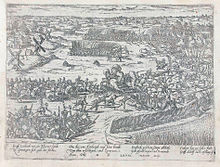Battle of Heiligerlee (1568)
 Spanish Empire
Spanish EmpireAdolf of Nassau †[2]
 Johan de Ligne †[3]
Johan de Ligne †[3]200 cavalry
20 cavalry
- v
- t
- e
Western Europe
- Beeldenstorm
- Valenciennes
- Wattrelos
- Lannoy
- Oosterweel
- Dahlen
- Heiligerlee
- Jemmingen
- Jodoigne
- Le Quesnoy
Western Europe
- Brielle
- Mons
- 1st Mechelen
- Goes
- Naarden
- Middelburg
- Haarlem
- IJsselmeer
- Alkmaar
- 1st Geertruidenberg
- Leiden
- Delft
- Valkenburg
- Mookerheyde
- Oudewater
- Schoonhoven
- Zierikzee
- European waters
- Flushing
- Borsele
- Haarlemmermeer
- Zuiderzee
- Reimerswaal
- Lillo
Western Europe
- 1st Antwerp
- Gembloux
- Rijmenam
- 1st Deventer
- Borgerhout
Western Europe
- 1st Maastricht
- 2nd Mechelen
- Diest
- 1st Steenwijk
- Kollum
- 1st Breda
- Noordhorn
- Niezijl
- Lochem
- 1st Lier
- 2nd Antwerp
- Eindhoven
- Steenbergen
- Ghent
- Aalst
- 3rd Antwerp
- Arnhem
- Empel
- Boksum
- 1st Grave
- 1st Venlo
- Axel
- Neuss
- 1st Rheinberg
- 1st Zutphen
- 1st Sluis
- European waters
- Ten Years, 1588–1598
Western Europe
- 1st Bergen op Zoom
- 2nd Geertruidenberg
- 2nd Breda
- 2nd Zutphen
- 2nd Deventer
- Delfzijl
- Knodsenburg
- 1st Hulst
- Nijmegen
- Rouen
- Caudebec
- 2nd Steenwijk
- 1st Coevorden
- 1st Luxemburg
- 3rd Geertruidenberg
- 2nd Coevorden
- Groningen
- 2nd Luxemburg
- Huy
- 1st Groenlo
- Lippe
- 2nd Lier
- Calais
- 2nd Hulst
- Turnhout
- 2nd Rheinberg
- 1st Meurs
- 2nd Groenlo
- Bredevoort
- Enschede
- Ootmarsum
- 1st Oldenzaal
- 1st Lingen
- European waters
Western Europe
- 1st Schenckenschans
- Zaltbommel
- Rees
- San Andreas
- Lekkerbeetje
- Nieuwpoort
- 3rd Rheinberg
- Ostend
- 1st 's-Hertogenbosch
- 2nd Grave
- Hoogstraaten
- 3rd Sluis
- 2nd Lingen
- 4th Rheinberg
- 3rd Groenlo
- European waters
- Dover Strait
- 2nd Sluis
- 1st Cape St. Vincent
- 1st Gibraltar
- Twelve Years' Truce, 1609–1621
Western Europe
- Aachen
East Indies
Western Europe
- Jülich
- 2nd Bergen op Zoom
- Fleurus
- 3rd Breda
- 2nd Oldenzaal
- 4th Groenlo
- 2nd 's-Hertogenbosch
- Meuse (2nd Maastricht, 2nd Venlo, 1st Roermond)
- 5th Rheinberg
- Leuven
- 2nd Schenkenschans
- 4th Breda
- 3rd Venlo
- 2nd Roermond
- Kallo
- 3rd Hulst
- 4th Hulst
European waters
- 2nd Gibraltar
- 2nd Cádiz
- Slaak
- Lizard Point
- Dunkirk
- 2nd English Channel
- The Downs
- 2nd Cape St. Vincent
Americas
- 1st Salvador
- Puerto Rico
- Bay of Matanzas
- Abrolhos
- Trujillo · Campeche
- 1st Saint Martin
- 2nd Salvador
- Itamaracá
- Southern Chile
- 2nd Saint Martin
East Indies
The Battle of Heiligerlee (Heiligerlee, Groningen, 23 May 1568)[4] was fought between Dutch rebels and the Spanish army of Friesland. It was the first Dutch victory during the Eighty Years' War.
The Groningen province of the Spanish Netherlands was invaded by an army consisting of 3,900 infantry, led by Louis of Nassau, and 200 cavalry, led by Adolf of Nassau. Both of them were brothers of William I of Orange. The intention was to begin an armed uprising against the Spanish rulers of the Netherlands.

The Stadtholder of Friesland and also Duke of Aremberg, Johan de Ligne, had an army of 3,200 infantry and 20 cavalry.
Aremberg initially avoided confrontation and awaited reinforcements from the Count of Meghem. However, on 23 May, Adolf's cavalry lured him to an ambush at the monastery of Heiligerlee. Louis's infantry made up the bulk of the army and defeated the Spanish force which lost 460 men, and the invading force lost 50, including Adolf. The rebels captured seven cannons.
The invading force, however, did not capture any cities and was soon defeated at the Battle of Jemmingen.
The death of Adolf of Nassau is mentioned in the Dutch national anthem (fourth verse):
- Graef Adolff is ghebleven, In Vriesland in den slaech,
- "Count Adolf has died, in Friesland, in the battle"
Notes
- ^ Dupuy, R. Ernest and Trevor N. Dupuy, Harper Encyclopedia of Military History, (HarperCollins Publishers, 1993), 528.
- ^ Menzel, Wolfgang, The history of Germany: from the earliest period to 1842, Vol.2, (George Bell & sons, 1908), 293.
- ^ Laffin, John, Brassey's Dictionary of Battles, (Barnes & Noble Inc., 1995), 194.
- ^ Laffin, 194.
References
- Dupuy, R. Ernest and Trevor N. Dupuy, The Harper Encyclopedia of Military History, (HarperCollins Publishers, 1993.
- Laffin, John, Brassey's Dictionary of Battles, Barnes & Noble Inc., 1995.
- Menzel, Wolfgang, The history of Germany: from the earliest period to 1842, Vol. 2, George Bell & sons, 1908.
- https://www.elcaminoespañol.com/la-epoca/232-efemerides-los-holandeses-invanden-holanda-o-la-batalla-de-heiligerlee/












